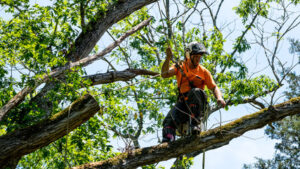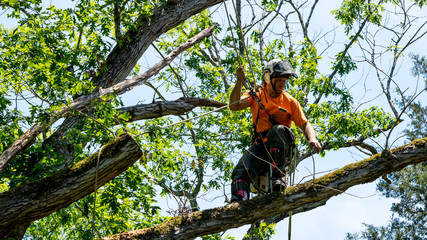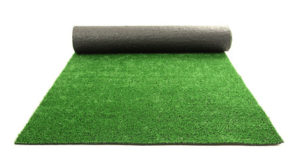Tree Trimming Irvine CA also known as pruning, is a crucial service that enhances the beauty of your trees. It removes dead and dying branches, opens vistas, repairs storm damage, maintains safety, and controls plant size.

It is essential for healthy growth, as overgrowth can lead to various issues like disease and insect infestations. It also improves the landscape by letting in sunlight and air circulation.
Thinning is the practice of selectively removing living branches from a tree to reduce its overall density. The goal is to improve tree health and structure by reducing competition for water, sunlight and nutrients. This increases tree growth, yields and timber quality. It also helps trees withstand environmental stresses such as wind, snow and ice. Thinning is done on a wide range of landscape and forest species including ornamental trees, fruit trees and hardwoods.
Thinning can be done by hand or mechanically (using heavy equipment). The type of thinning method is determined by the intended outcome. For example, to prepare a stand for logging, the overall high densities encountered in natural forests and reforestation plantations require thinning to open up access corridors large enough to accommodate the size of logging equipment. These openings are called clearings and may be flagged or marked to guide logging crews. The width and direction of these corridors will vary depending on the site, topography and desired per-acre density of the residual stand.
In addition, some foresters thin to create structural and spatial heterogeneity in a forest. This is often accomplished through variable density thinning, which results in some areas of the residual stand not being entered at all. These areas are called reserves and serve to retain a range of canopy tree diameters and help preserve snags, down wood and understory plants.
These areas are also often left undisturbed to provide habitat for a variety of wildlife species. In addition, the remaining wood can be decomposed naturally and provide saproxylic fungi and small mammals with an important resource.
Many foresters also perform thinning to reduce the risk of wildfire. When a forest is unthinned, the trees are often too close together and create dangerous fire conditions. Thinning helps prevent wildfire by reducing fuel buildup and making the forest more resilient to insect infestations and disease outbreaks.
In addition to fire mitigation, thinning can also be used as part of a restoration treatment to bring Oregon’s east-side forests back to their pre-fire suppression state. Wildfires were historically a normal part of the forest ecosystem, but because of forest management practices such as thinning, our forests are becoming too dense. These overcrowded forests are more vulnerable to disease and insect outbreaks, and are more likely to fuel larger and more destructive wildfires.
Crown Reduction
Crown reduction is a form of selective pruning that reduces the size and density of a tree’s canopy. It is often used to create more open space within the canopy, allow light penetration in urban areas, and promote new growth. It can also reduce the risk of damage from heavy snow or high winds, and increase tree health by removing dead branches that can be a fire hazard.
Expert arborists use precise cuts to encourage proper healing, reducing the risk of disease and pest infestation. Cuts should be made just outside of the branch collar (the swollen area where a branch attaches to the trunk) to prevent the resulting wound from becoming an entry point for pathogens.
Pruning and crown reduction are best performed during the dormant season, typically from late autumn through to early spring. This minimizes stress on the tree, allowing it to recover before its growing season. However, pruning and crown reduction times vary by species, so consult an arborist to find out when the best time is for your trees.
The crown, or canopy, of a tree is vital for the tree’s survival. It plays a key role in photosynthesis, helps to shield the roots from sun and wind, provides shade for wildlife, and adds beauty to landscapes. Overgrown crowns, however, can present a safety hazard during storms or strong winds, increasing the likelihood of damage to homes or power lines. Regular pruning and crown reduction can keep your trees healthy, reducing the need for expensive emergency tree services and prolonging their lives.
Properly maintained trees provide many benefits to property owners, including increased home value and curb appeal. When a tree is trimmed properly, it can be reduced in height and width while maintaining a balanced appearance. In addition, a well-maintained and aesthetically pleasing canopy can help to deter unwanted insect and animal activity in the surrounding garden or yard. When done improperly, however, pruning can be damaging to the structure of a tree, and can even lead to future problems. It is important to work with a certified and experienced tree service company for all of your pruning needs.
Canopy Lifting
If your trees have low-hanging branches that droop or sag to the ground, canopy lifting can be an effective solution. This technique involves pruning those lower limbs to raise the tree canopy and reduce the potential for damage during storms or high winds. While this might seem like a straightforward task, it requires the services of an experienced tree lopping company with expert arborists and precise pruning techniques to ensure the health and safety of your property.
A proper canopy lift will result in a higher canopy, increased clearance over sidewalks or driveways, and a more polished look. It also stunts the growth of the lower branches and encourages vertical growth, making the tree taller overall.
This is an important tree care service for urban areas because of the potential for traffic accidents and blockages caused by these low branches. When done correctly, canopy raising can help prevent these problems by providing better visibility.
The best time for canopy lifting is during the winter or early spring, when the weather is milder. This will minimize stress to the tree and help the cuts heal quickly. Experienced arborists use specific pruning techniques to reduce the risk of damage, such as cutting close to the branch collar and avoiding major wounds. They also take the time to tidy up and perform safety checks after each job.
Both canopy lifting and thinning improve the visual appeal of your property and provide many other benefits. Both techniques increase the amount of sunlight that reaches grass, gardens and other plants beneath the canopy, promoting their health and growth. They also allow more air to flow through the tree, reducing wind resistance and the potential for damage during storms.
When performed improperly, however, these tree trimming techniques can create serious issues. For example, if a tree is not properly thinned, it could develop multiple dominant stems that compete with each other. This can lead to weak Y-shaped structures that are more susceptible to failure in heavy loads or during high winds. A well-balanced canopy created by a professional will have one dominant leader and plenty of space for branches to grow out evenly.
Avoiding Damage
Tree trimming and pruning are essential tree care practices. When done properly, they promote proper growth for your trees and enhance their aesthetics. They also protect your property and family from damage caused by falling or leaning trees. However, many people misunderstand the difference between the two techniques. Both have distinct purposes and benefits, but the results are very different.
Improper tree cutting can cause serious harm to your property, resulting in damaged roofs, water leaks, or even structural collapse. The most common cause of tree damage is improper trimming, so it’s important to hire a professional for regular trimming services.
One of the biggest mistakes that can be made is trimming at the wrong time of year. This can cause stress to the tree, and reduce the ability of the roots to absorb nutrients. It’s also important to avoid thinning too much. If you thin out too much, the surviving branches may become weak and susceptible to damage from high winds. It is recommended to follow the one-third rule and only remove a third of the canopy at any given time to minimize stress.
Another common mistake is cutting too close to the trunk or main branches. This can expose the tree to rot and create wounds that will not heal, which will weaken the branches and structure of the tree. It’s also a good idea to trim branches that are growing into or touching other branches, which can lead to decay and disease.
A skilled tree trimmer can spot signs of a disease or pest infestation early on and prevent them from spreading throughout the entire tree or to other neighboring trees. They can also spot dead or weakened limbs and remove them before they fall.
A lot of people think that beautiful and healthy trees just grow that way, but that’s not always the case. Most of the time, their leafy crowns and balanced branch structure are a result of years of regular trimming done by professional tree pruners. If you want to maintain the beauty of your landscape and protect your home and family, contact a professional tree trimming company today for more information.




